The Temporal Variation of the Microclimate and Human Thermal Comfort in Urban Wetland Parks: A Case Study of Xixi National Wetland Park, China
Abstract
:1. Introduction
2. Target Site and Methods
2.1. Target Site
2.2. Methods
2.2.1. Monitoring and Data Sources
2.2.2. Assessment Indicators of HTC
2.2.3. Data Analysis
3. Results
3.1. Seasonal, Monthly, and Daily Variations of the Microclimate
3.1.1. Seasonal, Monthly, and Daily Variations of Temperature
3.1.2. Seasonal, Monthly, and Daily Variations of Relative Humidity
3.1.3. Seasonal, Monthly, and Daily Variations of Wind Speed
3.2. Seasonal, Monthly, and Daily Variations of the HTCI
3.2.1. Seasonal and Monthly Variations of the HTCI and Human Body Perception
3.2.2. Daily Variation of the HTCI
3.2.3. Daily Variation of the Human Body Perception
3.3. Seasonal, Monthly, and Daily Variations of the CTI
3.3.1. Seasonal and Monthly Variations of the CTI and Clothing Suggestions
3.3.2. Daily Variation of the CTI and Clothing Suggestions
4. Discussion
4.1. Ecosystem Services of Urban Wetland Parks in Terms of Microclimate Improvement
4.2. HTC Features of Urban Wetland Parks
4.3. Clothing Suggestions
5. Conclusions
Supplementary Materials
Author Contributions
Funding
Institutional Review Board Statement
Informed Consent Statement
Data Availability Statement
Conflicts of Interest
References
- Lai, D.; Zhou, C.; Huang, J.; Jiang, Y.; Long, Z.; Chen, Q. Outdoor space quality: A field study in an urban residential community in central China. Energy Build. 2014, 68, 713–720. [Google Scholar] [CrossRef]
- Schinasi, L.H.; Benmarhnia, T.; De Roos, A.J. Modification of the association between high ambient temperature and health by urban microclimate indicators: A systematic review and meta-analysis. Environ. Res. 2018, 161, 168–180. [Google Scholar] [CrossRef]
- Tsavdaroglou, M.; Al-Jibouri, S.H.; Bles, T.; Halman, J.I. Proposed methodology for risk analysis of interdependent critical infrastructures to extreme weather events. Int. J. Crit. Infrastruct. Prot. 2018, 21, 57–71. [Google Scholar] [CrossRef]
- Wazneh, H.; Arain, M.A.; Coulibaly, P. Climate indices to characterize climatic changes across southern Canada. Meteorol. Appl. 2019, 27, e1861. [Google Scholar] [CrossRef] [Green Version]
- Mitchell, M.G.E.; Suarez-Castro, A.F.; Martinez-Harms, M.; Maron, M.; McAlpine, C.; Gaston, K.J.; Johansen, K.; Rhodes, J.R. Reframing landscape fragmentation’s effects on ecosystem services. Trends Ecol. Evol. 2015, 30, 190–198. [Google Scholar] [CrossRef] [PubMed] [Green Version]
- Wlemm, K.; Heusinkvseld, B.G.; Lenzholzer, S.; Hove, B. Street greenery and its physical and psychological impact on thermal comfort. Landsc. Urban Plan. 2015, 138, 87–98. [Google Scholar]
- Mei, Y.; Sohngen, B.; Babb, T. Valuing urban wetland quality with hedonic price model. Ecol. Indic. 2018, 84, 535–545. [Google Scholar] [CrossRef]
- Bertassello, L.E.; Rao, P.S.C.; Park, J.; Jawitz, J.W.; Botter, G. Stochastic modeling of wetland-groundwater systems. Adv. Water Resour. 2018, 112, 214–223. [Google Scholar] [CrossRef]
- Park, J.; Wang, D.; Kumar, M. Spatial and temporal variations in the groundwater contributing areas of inland wetlands. Hydrol. Process. 2019, 34, 1117–1130. [Google Scholar] [CrossRef]
- Gutzwiller, K.J.; Flather, C. Wetland features and landscape context predict the risk of wetland habitat loss. Ecol. Appl. 2011, 21, 968–982. [Google Scholar] [CrossRef]
- Herbert, E.R.; Boon, P.; Burgin, A.J.; Neubauer, S.; Franklin, R.; Ardon, M.; Hopfensperger, K.N.; Lamers, L.P.M.; Gell, P. A global perspective on wetland salinization: Ecological consequences of a growing threat to freshwater wetlands. Ecosphere 2015, 6, art206. [Google Scholar] [CrossRef]
- Li, N.; Tian, X.; Li, Y.; Fu, H.; Jia, X.; Jin, G.; Jiang, M. Seasonal and Spatial Variability of Water Quality and Nutrient Removal Efficiency of Restored Wetland: A Case Study in Fujin National Wetland Park, China. Chin. Geogr. Sci. 2018, 28, 1027–1037. [Google Scholar] [CrossRef] [Green Version]
- Vanos, J.K.; Warland, J.S.; Gillespie, T.J.; Kenny, N.A. Review of the physiology of human thermal comfort while exercising in urban landscapes and implications for bioclimatic design. Int. J. Biometeorol. 2010, 54, 319–334. [Google Scholar] [CrossRef] [PubMed]
- Cheng, X.; Yang, L.; Cao, J.; Liang, D.; Song, G. Knowledge Mapping on Literature Research Progress of Human Thermal Comfort in buildings Based on Web of Science. IOP Conf. Ser. Earth Environ. Sci. 2020, 514. [Google Scholar] [CrossRef]
- Blazejczyk, K.; Epstein, Y.; Jendritzky, G.; Staiger, H.; Tinz, B. Comparison of UTCI to selected thermal indices. Int. J. Biometeorol. 2011, 56, 515–535. [Google Scholar] [CrossRef] [PubMed] [Green Version]
- Mughal, M.O.; Kubilay, A.; Fatichi, S.; Meili, N.; Carmeliet, J.; Edwards, P.; Burlando, P. Detailed investigation of microclimate by means of computational fluid dynamics (CFD) in a tropical urban environment. Urban Clim. 2021, 39, 10093. [Google Scholar] [CrossRef]
- Meili, N.; Manoli, G.; Burlando, P.; Carmeliet, J.; Chow, W.T.L.; Coutts, A.M.; Roth, M.; Velasco, E.; Vivoni, E.R.; Fatichi, S. Tree effects on urban microclimate: Diurnal, seasonal, and climatic temperature differences explained by separating radiation, evapotranspiration, and roughness effects. Urban For. Urban Green. 2021, 58, 126970. [Google Scholar] [CrossRef]
- Meili, N.; Acero, J.A.; Peleg, N.; Manoli, G.; Burlando, P.; Fatichi, S. Vegetation cover and plant-trait effects on outdoor thermal comfort in a tropical city. Build. Environ. 2021, 195, 107733. [Google Scholar] [CrossRef]
- Lai, D.; Guo, D.; Hou, Y.; Lin, C.; Chen, Q. Studies of outdoor thermal comfort in northern China. Build. Environ. 2014, 77, 110–118. [Google Scholar] [CrossRef]
- Chatzidimitriou, A.; Yannas, S. Microclimate development in open urban spaces: The influence of form and materials. Energy Build. 2015, 108, 156–174. [Google Scholar] [CrossRef]
- Estoque, R.C.; Murayama, Y.; Myint, S.W. Effects of landscape composition and pattern on land surface temperature: An urban heat island study in the megacities of Southeast Asia. Sci. Total. Environ. 2017, 577, 349–359. [Google Scholar] [CrossRef] [PubMed]
- Yang, B.; Olofsson, T.; Nair, G.; Kabanshi, A. Outdoor thermal comfort under subarctic climate of north Sweden—A pilot study in Umeå. Sustain. Cities Soc. 2017, 28, 387–397. [Google Scholar] [CrossRef]
- Zhao, Q.; Sailor, D.J.; Wentz, E.A. Impact of tree locations and arrangements on outdoor microclimates and human thermal comfort in an urban residential environment. Urban For. Urban Green. 2018, 32, 81–91. [Google Scholar] [CrossRef] [Green Version]
- Pan, L.; Cui, L.; Wu, M. Tourist behaviors in wetland park: A preliminary study in Xixi National Wetland Park, Hangzhou, China. Chin. Geogr. Sci. 2010, 20, 66–73. [Google Scholar] [CrossRef]
- Steadman, R.G. The assessment of sultriness. Part I: A temperature-humidity index based on human physiology and clothing science. J. Appl. Meteorol. 1979, 18, 861–873. [Google Scholar] [CrossRef] [Green Version]
- Sirangelo, B.; Caloiero, T.; Coscarelli, R.; Ferrari, E.; Fusto, F. Combining stochastic models of air temperature and vapour pressure for the analysis of the bioclimatic comfort through the Humidex. Sci. Rep. 2020, 10, 11395. [Google Scholar] [CrossRef]
- Masterton, J.M.; Richardson, F.A. Humidex: A Method of Quantifying Human Discomfort Due to Excessive Heat and Humidity; CLI1-79, Environment Canada, Atmospheric Environment: Toronto, ON, Canada, 1979. [Google Scholar]
- Houghton, F.C.; Yaglou, C.P. Determining Equal Comfort Lines. J. Am. Soc. Heat. Vent. Eng. 1923, 29, 165–176. [Google Scholar]
- ISO 7243. Hot environments—Estimation of the Heat Stress on Working Man, Based on the WBGT Index (Wet Bulb Globe Temperature); International Standardization Organisation: Geneva, Switzerland, 1989. [Google Scholar]
- Alfano, F.R.D.; Palella, B.I.; Riccio, G. On the Problems Related to Natural Wet Bulb Temperature Indirect Evaluation for the Assessment of Hot Thermal Environments by Means of WBGT. Ann. Occup. Hyg. 2012, 56, 1063–1079. [Google Scholar] [CrossRef] [Green Version]
- Lin, L.; Luo, M.; Chan, T.O.; Ge, E.; Liu, X.; Zhao, Y.; Liao, W. Effects of urbanization on winter wind chill conditions over china. Sci. Total Environ. 2019, 688, 389–397. [Google Scholar] [CrossRef] [PubMed]
- Gagge, A.P.; Stolwijk, J.A.J.; Nishi, Y. An effective temperature scale based on a simple model of human physiological regulatory response. Ashrae Trans. 1971, 77, 21–36. [Google Scholar]
- Gagge, A.P.; Fobelets, A.P.; Berglund, L.G. A standard predictive index of human response to the thermal environment. Ashrae Trans. 1986, 92, 709–731. [Google Scholar]
- ISO 11079. Evaluation of Cold Environments: Determination of Required Clothing Insulation (IREQ); International Standardization Organisation: Geneva, Switzerland, 2007. [Google Scholar]
- Alfano, F.R.D.; Palella, B.I.; Riccio, G. Notes on the implementation of the IREQ model for the assessment of extreme cold environments. Ergonomics 2013, 56, 707–724. [Google Scholar] [CrossRef] [PubMed]
- ISO 7933. Ergonomics of the Thermal Environment: Analytical Determination and Interpretation of Heat Stress Using Calculation of the Predicted Heat Strain; International Standardization Organisation: Geneva, Switzerland, 2004. [Google Scholar]
- Alfano, F.R.D.; Palella, B.I.; Riccio, G. Thermal Environment Assessment Reliability Using Temperature—Humidity Indices. Ind. Health 2011, 49, 95–106. [Google Scholar] [CrossRef] [PubMed] [Green Version]
- Höppe, P. The physiological equivalent temperature—A universal index for the biometeorological assessment of the thermal environment. Int. J. Biometeorol. 1999, 43, 71–75. [Google Scholar] [CrossRef] [PubMed]
- Jendritzky, G.; Bessemoulin, P.; Blazejczyk, K.; Cegnar, T.; Dittmann, E.; Fiala, D.; Nicol, F.; Havenith, G.; Hassi, J.; Höppe, P.; et al. Towards a Universal Thermal Climate Index UTCI for Assessing the Thermal Environment of the Human Being; Final Report COST Action 730; European Concerted Research Action: Freiburg, Germany, 2009. [Google Scholar]
- Lu, D.; Cui, S.; Li, C. The Influence of Beijing Urban Greening and Summer Microclimate Conditions on Human Fitness; Forestry and Metrology Papers; Meteorological Press: Beijing, China, 1984; pp. 144–152. (In Chinese) [Google Scholar]
- Gu, L.; Wang, C.; Wang, Y.; Wang, X.; Sun, Z.; Wang, Q.; Sun, R. Patterns of temporal variation of microclimate and extent of human comfort in the recreation forests in Huishan National Forest Park. Sci. Silvae Sin. 2019, 55, 150–159. (In Chinese) [Google Scholar]
- Jin, G.; Liu, H.; Lu, Z.; Wu, J.; Xu, L.; Sun, G.; Li, P.; Li, J.; Xu, C. Canopy structures and degree of comfort with urban forests of Beijing in summer. J. Zhejiang AF Univ. 2019, 36, 550–556. (In Chinese) [Google Scholar]
- Zhu, L.; Qian, P.; Qian, Y. Weather index study for clothing. Sci. Meteorol. Sin. 2001, 21, 468–473. (In Chinese) [Google Scholar]
- Rapp, J.M.; Silman, M.R. Diurnal, seasonal, and altitudinal trends in microclimate across a tropical montane cloud forest. Clim. Res. 2012, 55, 17–32. [Google Scholar] [CrossRef]
- Vinogradova, V. Using the Universal Thermal Climate Index (UTCI) for the assessment of bioclimatic conditions in Russia. Int. J. Biometeorol. 2020, 65, 1473–1483. [Google Scholar] [CrossRef]
- An, L.; Hong, B.; Cui, X.; Geng, Y.; Ma, X. Outdoor thermal comfort during winter in China’s cold regions: A comparative study. Sci. Total Environ. 2021, 768, 144464. [Google Scholar] [CrossRef]
- Georgi, N.J.; Zafiriadis, K. The impact of park trees on microclimate in urban areas. Urban Ecosyst. 2006, 9, 195–209. [Google Scholar] [CrossRef]
- Wu, Z.; Chen, L. Optimizing the spatial arrangement of trees in residential neighborhoods for better cooling effects: Integrating modeling with in-situ measurements. Landsc. Urban Plan. 2017, 167, 463–472. [Google Scholar] [CrossRef]
- Atwa, S.; Ibrahim, M.G.; Murata, R. Evaluation of plantation design methodology to improve the human thermal comfort in hot-arid climatic responsive open spaces. Sustain. Cities Soc. 2020, 59, 102198. [Google Scholar] [CrossRef]
- Hu, L.; Li, Q. Greenspace, bluespace, and their interactive influence on urban thermal environments. Environ. Res. Lett. 2020, 15, 034041. [Google Scholar] [CrossRef]
- Lin, Y.-H.; Tsai, K.-T. Screening of Tree Species for Improving Outdoor Human Thermal Comfort in a Taiwanese City. Sustainability 2017, 9, 340. [Google Scholar] [CrossRef] [Green Version]
- Soydan, O. Effects of landscape composition and patterns on land surface temperature: Urban heat island case study for Nigde, Turkey. Urban Clim. 2020, 34, 100688. [Google Scholar] [CrossRef]
- Gkatsopoulos, P. A Methodology for Calculating Cooling from Vegetation Evapotranspiration for Use in Urban Space Microclimate Simulations. Procedia Environ. Sci. 2017, 38, 477–484. [Google Scholar] [CrossRef]
- Liu, W.; Zhang, Y.; Deng, Q. The effects of urban microclimate on outdoor thermal sensation and neutral temperature in hot-summer and cold-winter climate. Energy Build. 2016, 128, 190–197. [Google Scholar] [CrossRef]
- Kántor, N.; Kovács, A.; Takács, Á. Seasonal differences in the subjective assessment of outdoor thermal conditions and the impact of analysis techniques on the obtained results. Int. J. Biometeorol. 2016, 60, 1615–1635. [Google Scholar] [CrossRef] [PubMed] [Green Version]
- Yuan, C.; Adelia, A.S.; Mei, S.; He, W.; Li, X.-X.; Norford, L. Mitigating intensity of urban heat island by better understanding on urban morphology and anthropogenic heat dispersion. Build. Environ. 2020, 176, 106876. [Google Scholar] [CrossRef]
- Gaudio, N.; Gendre, X.; Saudreau, M.; Seigner, V.; Balandier, P. Impact of tree canopy on thermal and radiative microclimates in a mixed temperate forest: A new statistical method to analyse hourly temporal dynamics. Agric. For. Meteorol. 2017, 237–238, 71–79. [Google Scholar] [CrossRef] [Green Version]
- Peng, X.; Wu, W.; Zheng, Y.; Sun, J.; Hu, T.; Wang, P. Correlation analysis of land surface temperature and topographic elements in Hangzhou, China. Sci. Rep. 2020, 10, 1–16. [Google Scholar] [CrossRef] [PubMed]

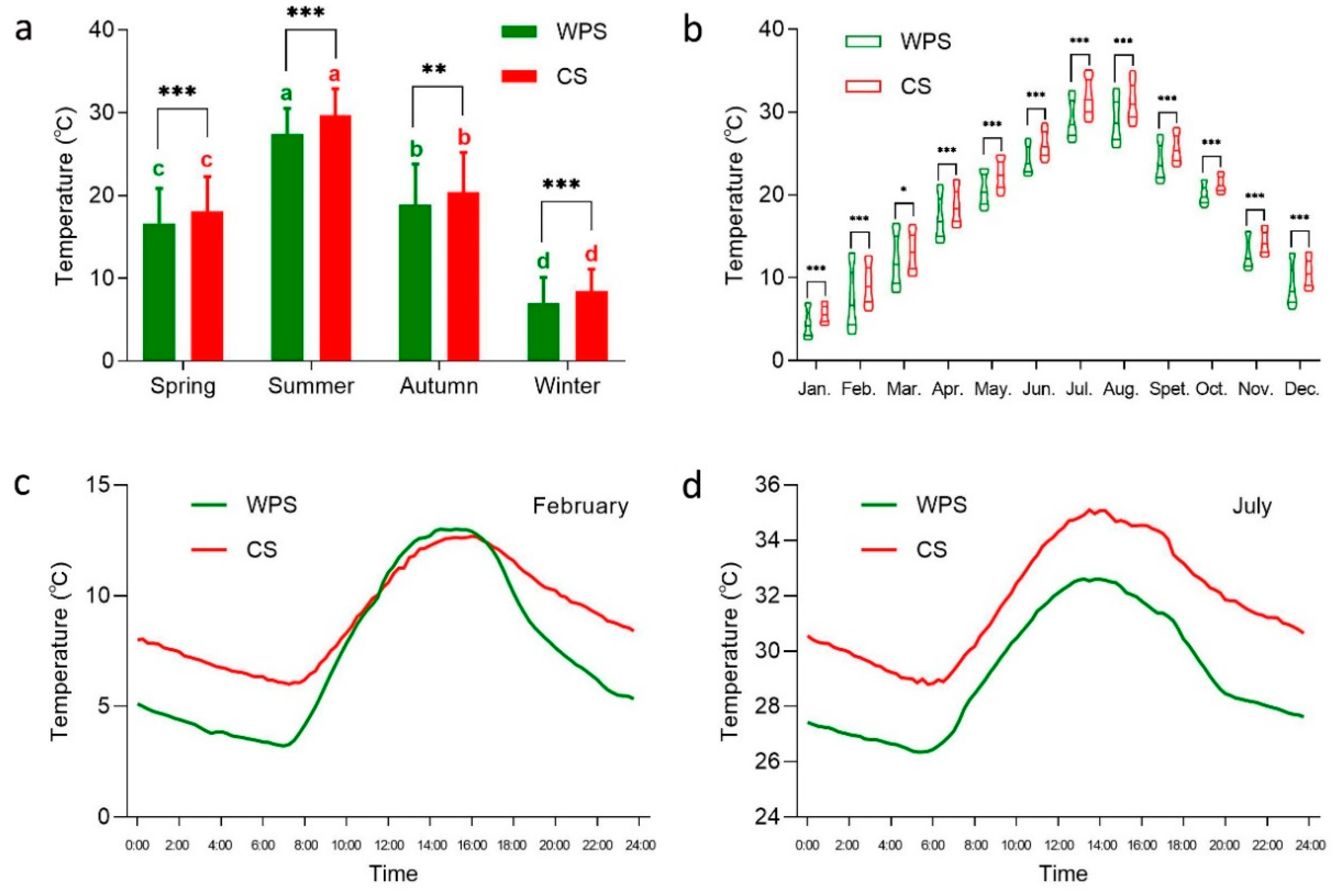

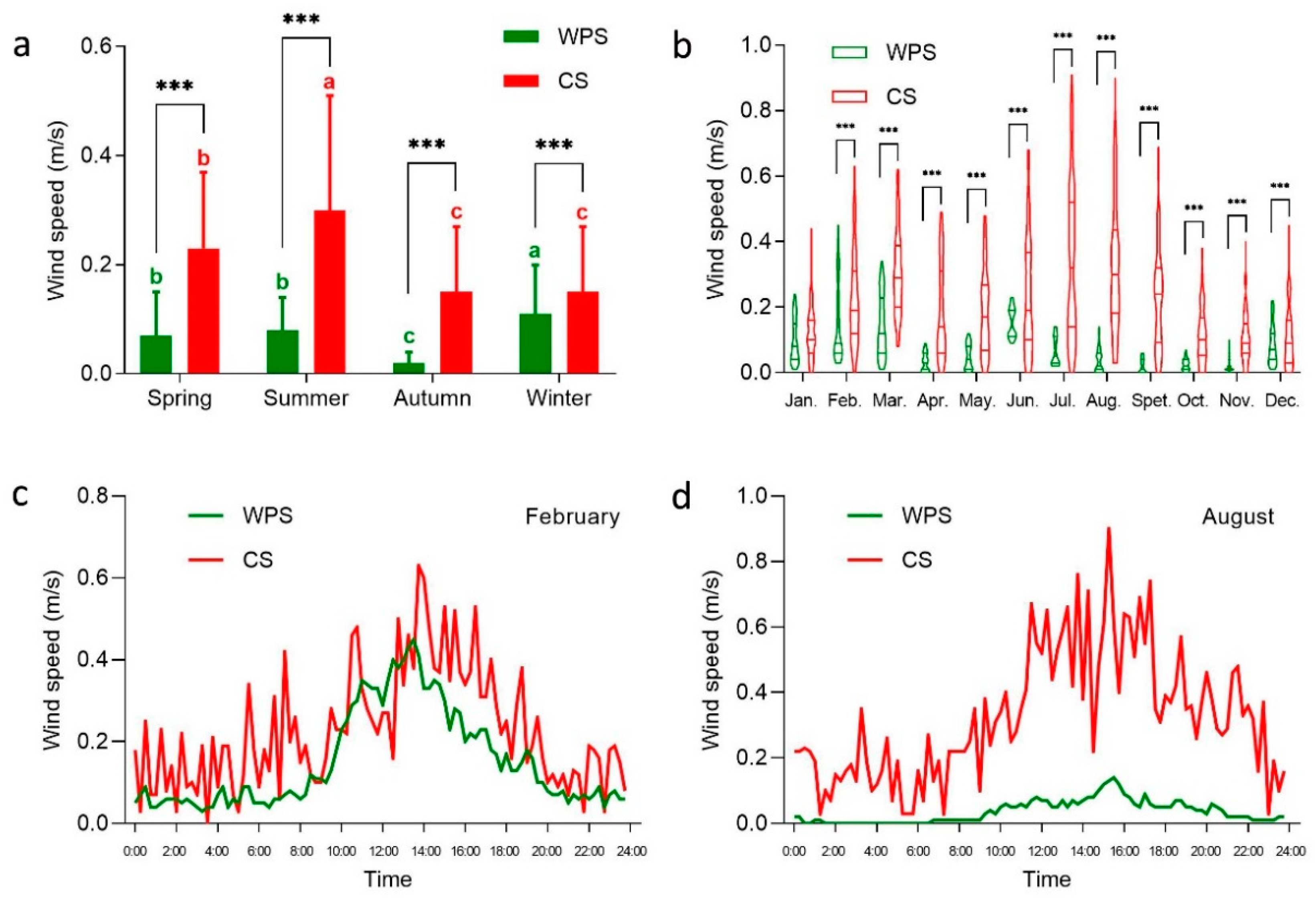
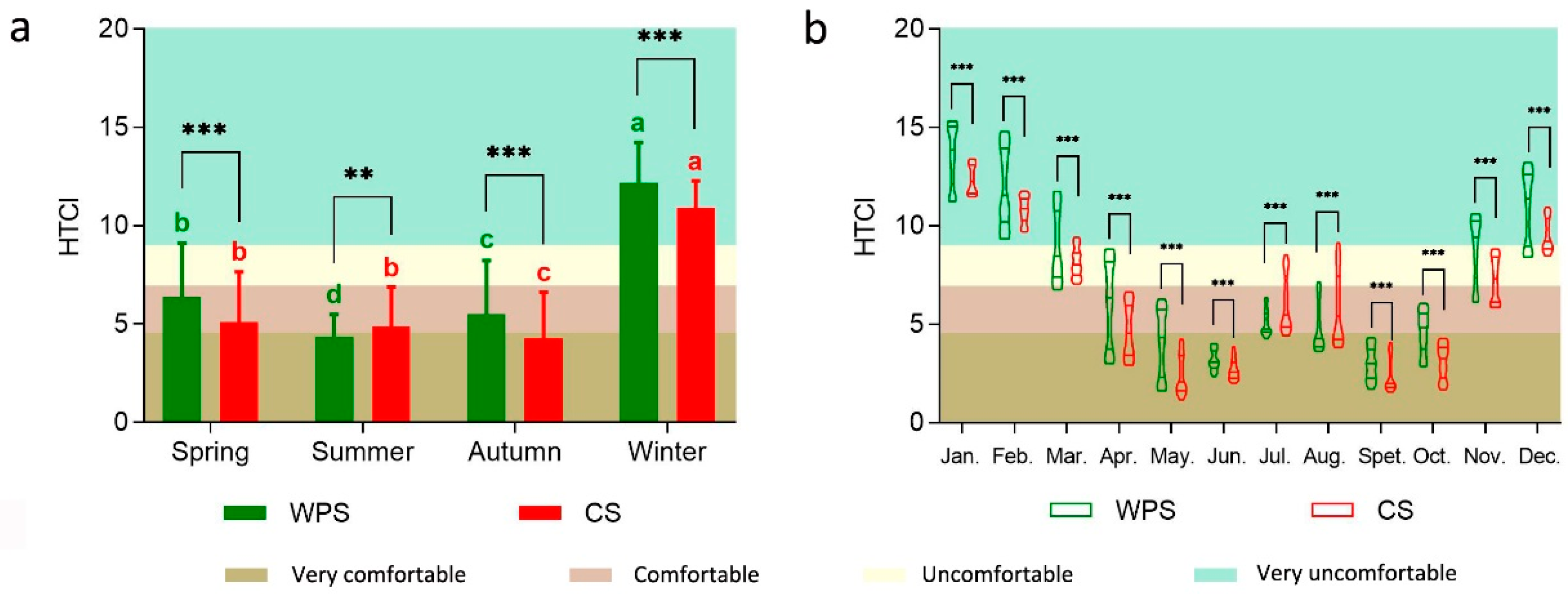
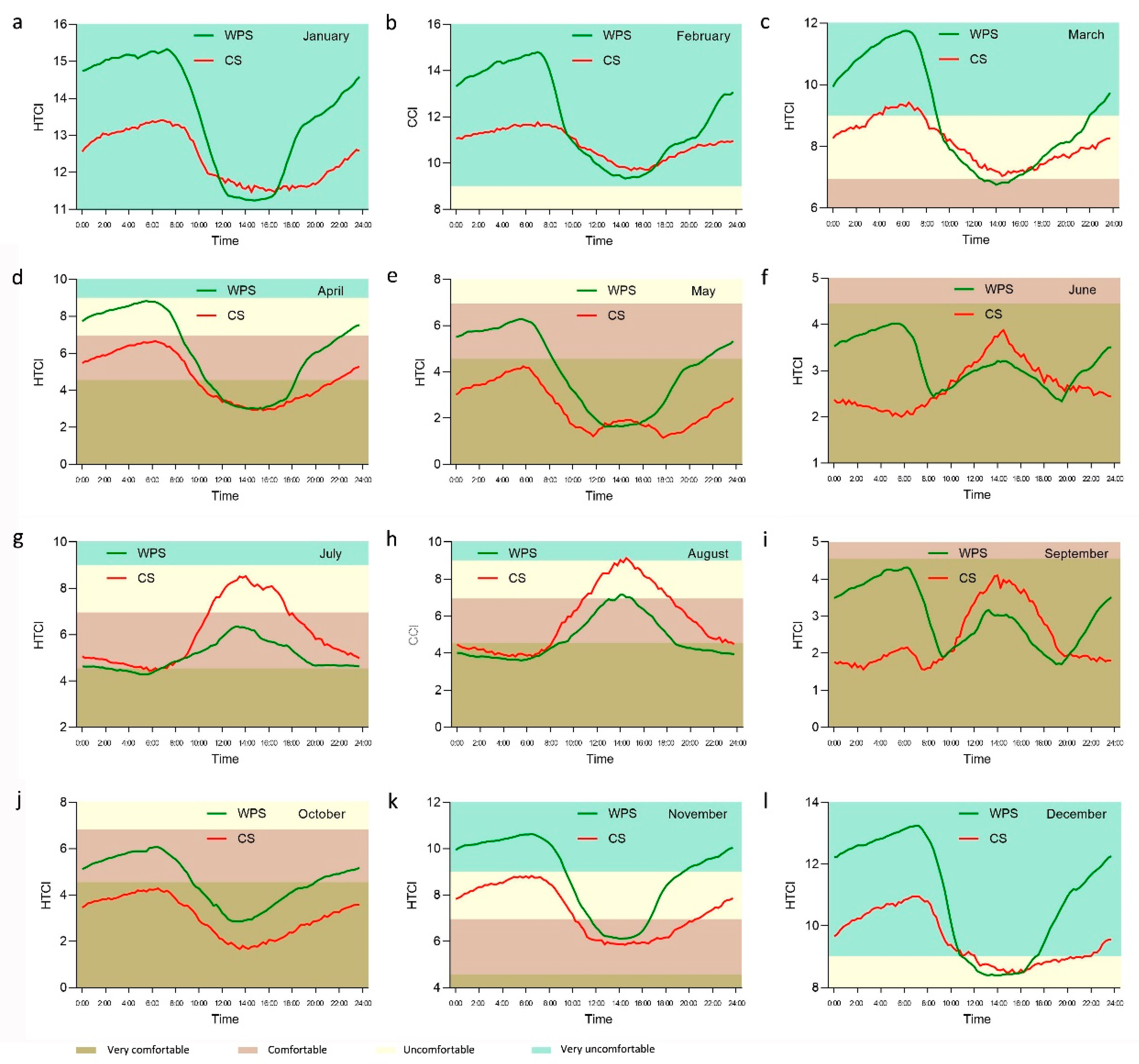
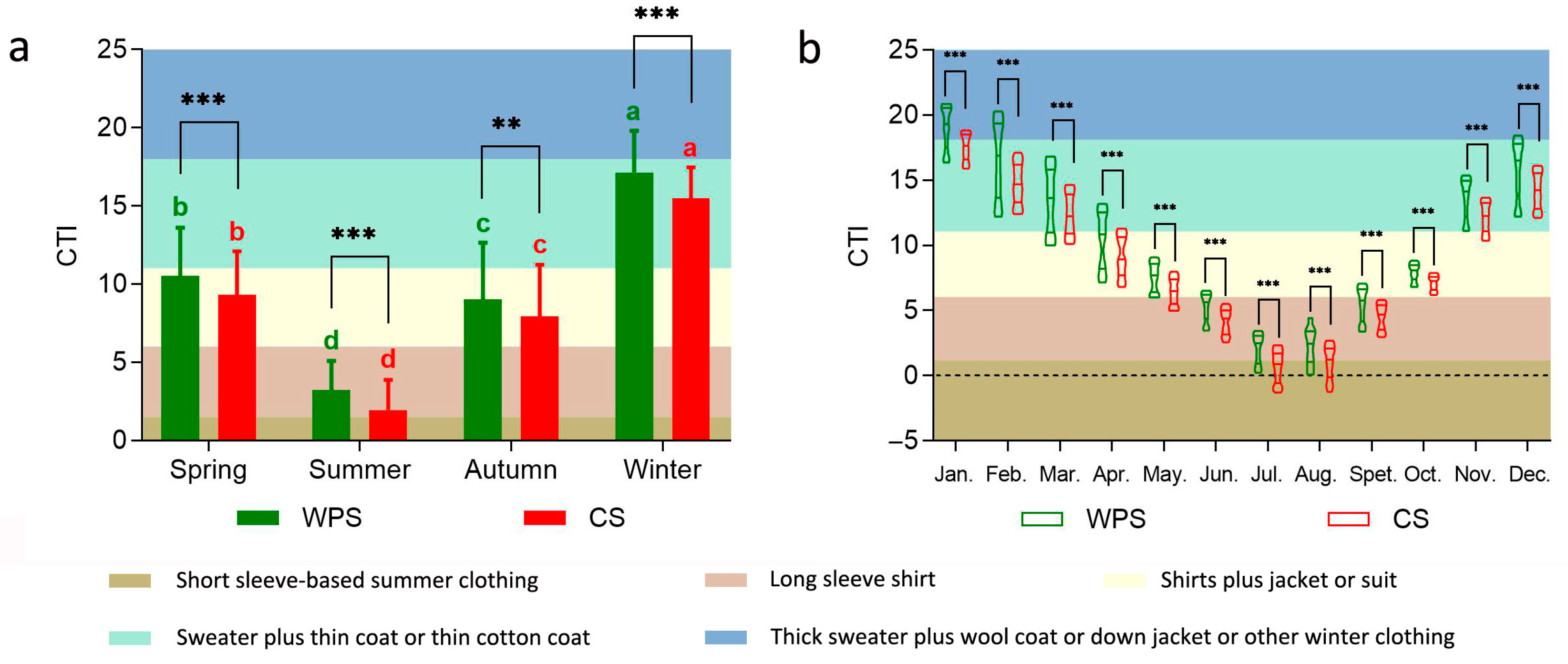
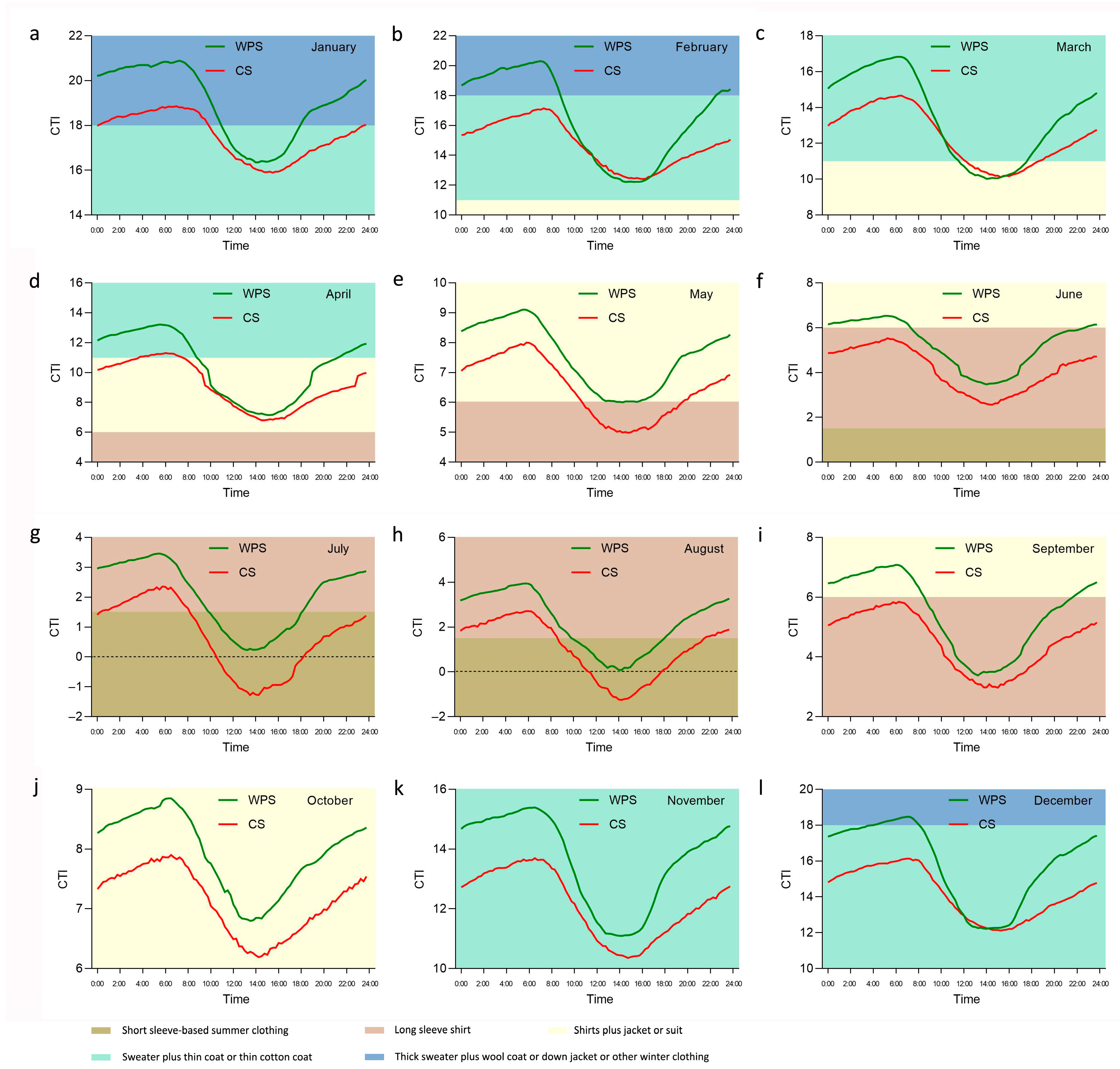
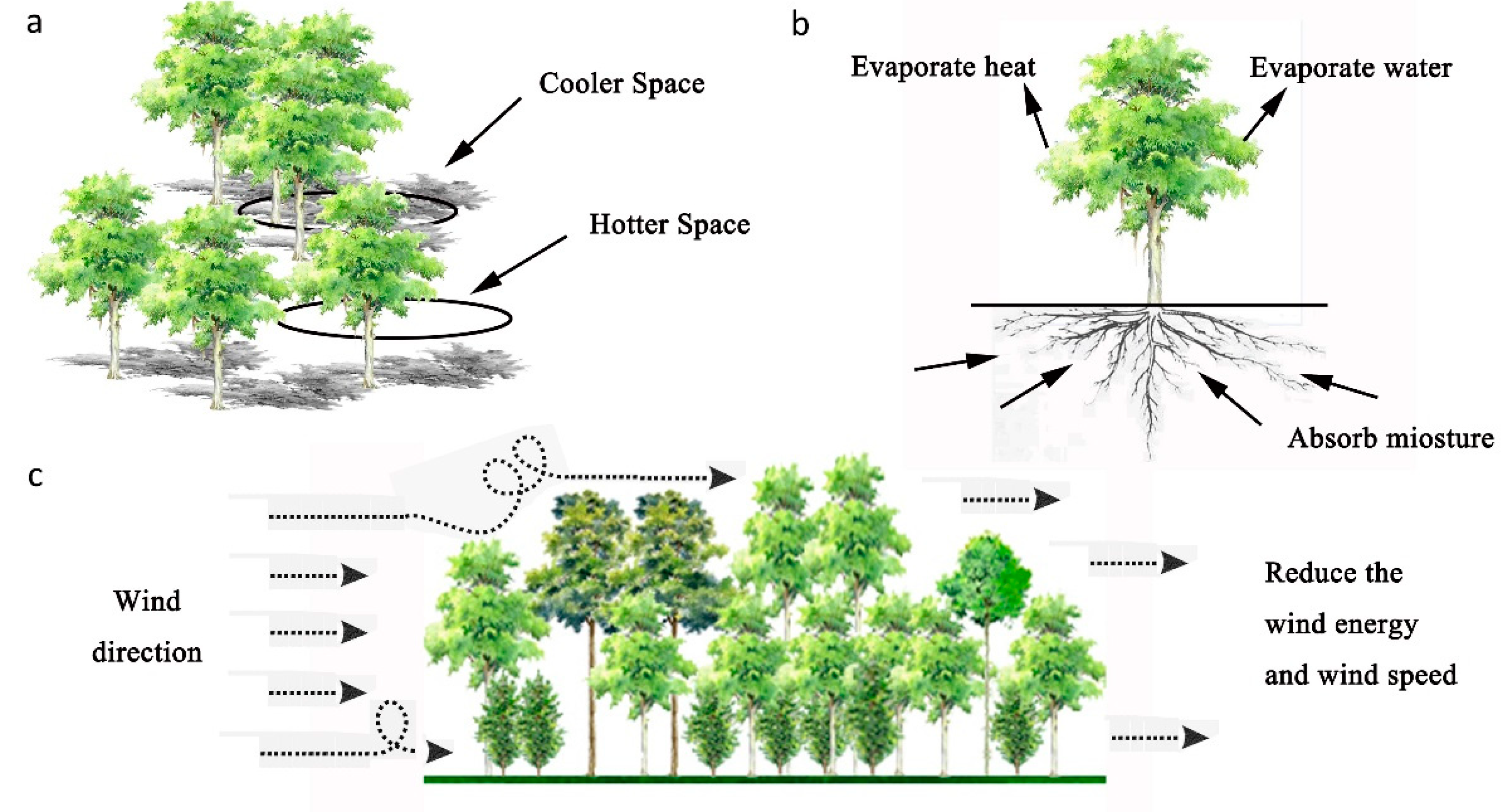
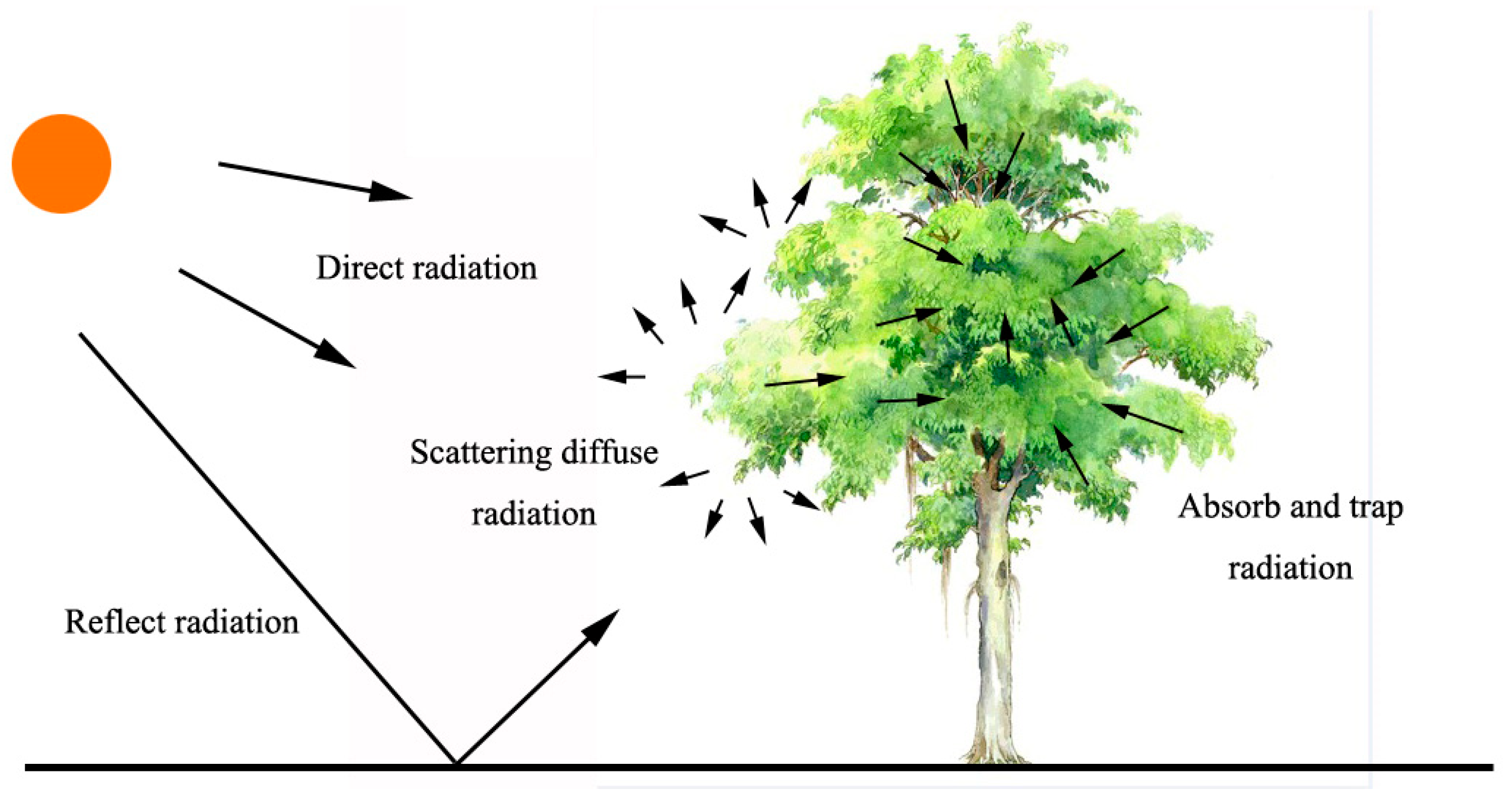
| Sensors | Product Type | Work Environment | Measuring Range | Accuracy |
|---|---|---|---|---|
| Temperature and humidity sensor | HMP155 | −40–60 °C, 0–60 % | ±0.2 °C, ±1% | |
| Anemometer | Set03002-1 | −20–50 °C | 0–60 m/s | ±0.5 m/s |
| Data collector | CR1000 | −20–65 °C |
| Indices | Combined Environmental Variables | Applicable Weather Conditions | References |
|---|---|---|---|
| Heat index (HI) | Air temperature and relative humidity | Hot weather | Steadman [25] |
| Humidex (HD) | Air temperature and air vapor pressure | Hot weather | Sirangelo et al. [26] and Masterton and Richardson [27] |
| Effective temperature (ET) | Air temperature, relative humidity, and wind speed | Hot and warm weather | Houghton and Yaglou [28] |
| Wet-bulb globe temperature (WBGT) | Air temperature, globe temperature, and natural wet bulb temperature | Hot weather | ISO 7243 [29] and d’Ambrosio Alfano et al. [30] |
| Wind chill index (WCI) | Air temperature and wind speed | Cold weather | Lin et al. [31] and Blazejczyk et al. [15] |
| Standard effective temperature (SET) | Air temperature, relative humidity, and mean radiant temperature | Hot weather | Gagge et al. [32] and Gagge et al. [33] |
| Insulation required (IREQ) | Air temperature, mean radiant temperature, relative humidity, and air velocity | Cold weather | ISO 11079 [34] and d’Ambrosio Alfano et al. [35] |
| Predicted heat strain (PHS) | Air temperature, mean radiant temperature, relative humidity, and air velocity | Hot weather | ISO 7933 [36] and d’Ambrosio Alfano et al. [37] |
| Physiological equivalent temperature (PET) | Air temperature, air vapor pressure, wind speed, and mean radiant temperature | Hot and cold weather | Höppe [38] |
| Universal Thermal Climate Index (UTCI) | Air temperature, mean radiant temperature, air vapor pressure, and wind speed | Hot and cold weather | Jendritzky et al. [39] |
| Indices | Combined Environmental Variables | Equations * | Applicable Weather Conditions |
|---|---|---|---|
| Human thermal comfort index (HTCI) | Air temperature, relative humidity, and wind speed | HTCI = | Hot and cold weather |
| Thermal humidity index (THI) | Air temperature and relative humidity | THI = | Hot weather |
| Human comfort index (HCI) | Air temperature, relative humidity, and wind speed | HCI = | Hot and cold weather |
| Discomfort index (DI) | Air temperature and relative humidity | DI = | Hot weather |
| Cool index (CI) | Air temperature, and wind speed | CI = | Cold weather |
| Level | Range | Feeling |
|---|---|---|
| I | HTCI ≤ 4.55 | Very comfortable |
| II | 4.55 < HTCI ≤ 6.95 | Comfortable |
| III | 6.95 < HTCI ≤ 9.00 | Uncomfortable |
| IV | HTCI > 9.00 | Very uncomfortable |
| Level | Range | Clothing Suggestion |
|---|---|---|
| I | CTI ≤ 1.5 | Short-sleeve-based summer clothing |
| II | 1.5 < CTI ≤ 6 | Long-sleeve shirt |
| III | 6 < CTI ≤ 11 | Shirts plus a jacket or suit |
| IV | 11 < CTI ≤ 18 | Sweater plus a thin coat or thin cotton coat |
| V | CTI > 18 | Thick sweater plus a wool coat or down jacket or other winter clothing |
Publisher’s Note: MDPI stays neutral with regard to jurisdictional claims in published maps and institutional affiliations. |
© 2021 by the authors. Licensee MDPI, Basel, Switzerland. This article is an open access article distributed under the terms and conditions of the Creative Commons Attribution (CC BY) license (https://creativecommons.org/licenses/by/4.0/).
Share and Cite
Zhang, Z.; Dong, J.; He, Q.; Ye, B. The Temporal Variation of the Microclimate and Human Thermal Comfort in Urban Wetland Parks: A Case Study of Xixi National Wetland Park, China. Forests 2021, 12, 1322. https://doi.org/10.3390/f12101322
Zhang Z, Dong J, He Q, Ye B. The Temporal Variation of the Microclimate and Human Thermal Comfort in Urban Wetland Parks: A Case Study of Xixi National Wetland Park, China. Forests. 2021; 12(10):1322. https://doi.org/10.3390/f12101322
Chicago/Turabian StyleZhang, Zhiyong, Jianhua Dong, Qijiang He, and Bing Ye. 2021. "The Temporal Variation of the Microclimate and Human Thermal Comfort in Urban Wetland Parks: A Case Study of Xixi National Wetland Park, China" Forests 12, no. 10: 1322. https://doi.org/10.3390/f12101322
APA StyleZhang, Z., Dong, J., He, Q., & Ye, B. (2021). The Temporal Variation of the Microclimate and Human Thermal Comfort in Urban Wetland Parks: A Case Study of Xixi National Wetland Park, China. Forests, 12(10), 1322. https://doi.org/10.3390/f12101322






